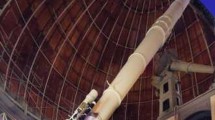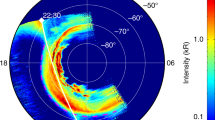Abstract
This paper presents high contrast images of sky sources, obtained from the ground with a novel optical concept: Fresnel arrays. We demonstrate the efficiency of a small 20 cm prototype Fresnel array for making images with high brightness ratios, achieving contrasts up to 4 × 105 on sky sources such as Mars and its satellites, and the Sirius A–B couple. These validation results are promising for future applications in space, for example the 4 m array we have proposed to ESA in the frame of the “Call for a Medium-size mission opportunity for a launch in 2022”. Fresnel imagers are the subject of a topical issue of Experimental Astronomy published in 2011, but only preliminary results were presented at the time. Making images of astronomical bodies requires an optical component to focus light. This component is usually a mirror or a lens, the quality of which is critical for sharp and high contrast images. However, reflection on a mirror and refraction through a lens are not the only ways to focus light: an alternative is provided by diffraction through binary masks (opaque foils with multiple precisely etched sub-apertures). Our Fresnel arrays are such diffractive focusers, they offer weight, price and size advantages over traditional optics in space-based astronomical instruments. This novel approach requires only void apertures of special shapes in an opaque material to form sharp images, thus avoiding the wavefront distortion, diffusion and spectral absorption associated with traditional optical media. In our setup, lenses and/or mirrors are involved only downstream (at small sizes) for focal instrumentation and chromatic correction. Fresnel arrays produce high contrast images, the resolution of which reaches the theoretical limit of diffraction. Unlike mirrors, they do not require high precision polishing or positioning, and can be used in a large domain of wavelengths from far IR to far UV, enabling the study of many science cases in astrophysics from exoplanet surfaces and atmospheres to galaxy evolution.





Similar content being viewed by others
References
Andersen, G.: Large optical photon sieve. Opt. Lett. 30, 2976–2978 (2005)
Baez, A.: Fresnel zone plate for optical image formation using extreme ultraviolet and soft x radiation. J. Opt. Soc. Am. 51(4), 405–412 (1961)
Barton, I.M., et al.: Fabrication of large-aperture lightweight diffractive lenses for use in space. Appl. Opt. 40, 447–451 (2001)
Chesnokov, Y.M.: A space-based very high angular resolution telescope. Russ. Space Bull. 1, 18–21 (1993)
Deba, P., Etcheto, P., Duchon P.: Preparing the way to space borne Fresnel imagers: space scenarios optical layouts. Exp. Astron. 30(2–3), 123–136 (2010). doi:10.1007/s10686-010-9202-5
Early, J.T.: Large space telescopes using Fresnel lens for power beaming, astronomy and sail missions. In: Beamed Energy Propulsion: First International Symposium on Beamed Energy Propulsion, AIP Conference Proceeding, vol. 664, pp. 399–410 (2003)
Faklis, D., Morris, G.M.: Broadband imaging with holographic lenses. Opt. Eng. 28(6), 592–598 (1989)
Fresnel, A.: Mémoire sur la diffraction de la lumière. Archives des sciences physiques et naturelles, académie des sciences, Paris. Tome V, 339–475 (1818)
Gardner, J.P., et al.: The James Webb space telescope. Space Sci. Rev. 123, 485–606 (2006). doi:10.1007/s11214-006-8315-7
Gomez de Castro, A.-I., Lecavelier, A., D’Avillez, M., Linsky, J.L., Cernicharo, J.: UV capabilities to probe the formation of planetary systems: from the ISM to planets. ApSS 303, 33–52 (2006)
Gomez de Castro, A.I.: The Fresnel space imager as a disk evolution watcher. Exp. Astron. 30(2–3), 205–216 (2011). doi:10.1007/s10686-011-9223-8
Guyon, O.: Phase-induced amplitude apodization of telescope pupils for extrasolar terrestrial planet imaging. Astron. Astrophys. 404, 379–387 (2003)
Hestroffer, D., dellÕOro, A., Cellino, A., Tanga, P.: The Gaia mission and the asteroids. Lect. Notes Phys. 790, 251–340 (2010). doi:10.1007/978-3-642-04458-86
Hinglais, E.: A space Fresnel imager concept assessment study led by CNES for astrophysical applications. Exp. Astron. 30(2–3), 85–110 (2011). doi:10.1007/s10686-011-9218-5
Hyde, R.A.: Eyeglass. 1. Very large aperture diffractive telescopes. Appl. Opt. 38, 4198–4212 (1999)
Kipp, L., et al.: Sharper images by focusing soft X-rays with photon sieves. Nature 414, 184–188 (2001)
Koechlin, L., Perez, J-P.: A limit in Field-resolution ratio for interferometric arrays. In: Traub, W. (ed.) Interferometry for Optical Astronomy, II. SPIE Proc., vol. 4838, pp. 411–415. Hawaii (2002)
Koechlin, L., Serre, D., Duchon, P.: High resolution imaging with Fresnel interferometric arrays: suitability for exoplanet detection. Astron. Astrophys. 443, 709–720 (2005)
Koechlin, L., Rivet, J.-P., Gomez de Castro, A.I.: Fresnel arrays and their astrophysical applications. Exp. Astron. 30(2–3), 83–84 (2011). doi:10.1007/s10686-011-9225-6
Koechlin, L., et al.: Generation 2 testbed of Fresnel imager: first results on the sky. Exp. Astron. 30(2–3), 165–182 (2011). doi:10.1007/s10686-010-9203-4
Martin, S.R., et al.: A midinfrared nuller for terrestrial planet finder: design, progress, and results. In: Coulter, D.R. (ed.) Techniques and Instrumentation for Detection of Exoplanets. SPIE Proc., vol. 5170, pp. 144–154 (2003)
Mennesson, B., Leger, A., Ollivier, M.: Direct detection and characterization of extrasolar planets: the Mariotti space interferometer. Icarus 178(2), 570–588 (2005). doi:10.1016/j.icarus.2005.05.012
Nisenson, P., Papaliolios, C.: Detection of earth-like planets using apodized telescopes. Astrophys. J. 548, L201–L205 (2001)
Pello, R., Maizy, A., Richard, J.: Extragalactic science with the FRESNEL imager. Exp. Astron. 30(2–3), 195–204 (2011). doi:10.1007/s10686-010-9206-1
Raksasataya, T., Gomez de Castro, A.I., Koechlin, L., Rivet, J.-P.: A space Fresnel imager for ultra-violet astrophysics: example on accretion disks. Exp. Astron. 30(2–3), 183–194 (2011). doi:10.1007/s10686-011-9221-x
Rivet, J.-P., Koechlin, L., Raksasataya, T., Deba, P., Gili, R.: Fresnel imager testbeds: setting up, evolution and first images. Exp. Astron. 30(2–3), 149–164 (2011). doi:10.1007/s10686-011-9213-x
Shao, M., Catanzarite, J., Pan, X.: The synergy of direct imaging and astrometry for orbit determination of exo-earths. Astroph. J. 720, 357 (2010)
Serre, D., Deba, P., Koechlin, L.: Fresnel interferometric imager: ground-based prototype. Appl. Opt. 48(15), 2811–2820 (2009)
Serre, D.: The Fresnel imager: instrument numerical model. Exp. Astron. 30(2–3), 111–121 (2011). doi:10.1007/s10686-010-9200-7
Serre, D., Koechlin, L., Deba, P.: The Fresnel imager: learning from ground-based generation I prototype. Exp. Astron. 30(2–3), 137–147 (2010). doi:10.1007/s10686-010-9201-6
Soret, J.-L.: Sur les phénomènes de diffraction produits par les réseaux circulaires. Arch. Sci. Phys. Nat. 52, 320–337 (1875)
Schupmann, L.: Die medial-fernrohre: eine neue konstruktion f–r grosse astronomische instrumente. Teubner B G (1899)
Tanga, P., Hestroffer, D., Delbo, M., Richardson, D.C.: Asteroid rotation and shapes from numerical simulations of gravitational re-accumulation. Planet. Space Sci. 57, 193–200 (2009). doi:10.1016/j.pss.2008.06.016
Acknowledgements
This work has been funded by CNES, Université de Toulouse, CNRS, Foundation STAE, and Thales Alenia Space. It was made possible thanks to the involvement of many people at Observatoire Midi Pyrénées and Observatoire de la Côte d’Azur for the mechanics of the test-bed. The primary array has been cut to our specifications by “Micro Usinage Laser”, the secondary Fresnel lens etched by “Silios Technologies”. Thanks to a suggestion by J.-L. Prieur, we have benefited from a large nineteenth century telescope, funded in 1882 by R.Bishoffscheim, and still operational more than 125 years later for testing future space projects such as ours. Special thanks to C. Evans-Pughe and Clive Coen for their help with the text.
Author information
Authors and Affiliations
Corresponding author
Rights and permissions
About this article
Cite this article
Koechlin, L., Rivet, JP., Deba, P. et al. First high dynamic range and high resolution images of the sky obtained with a diffractive Fresnel array telescope. Exp Astron 33, 129–140 (2012). https://doi.org/10.1007/s10686-011-9277-7
Received:
Accepted:
Published:
Issue Date:
DOI: https://doi.org/10.1007/s10686-011-9277-7




